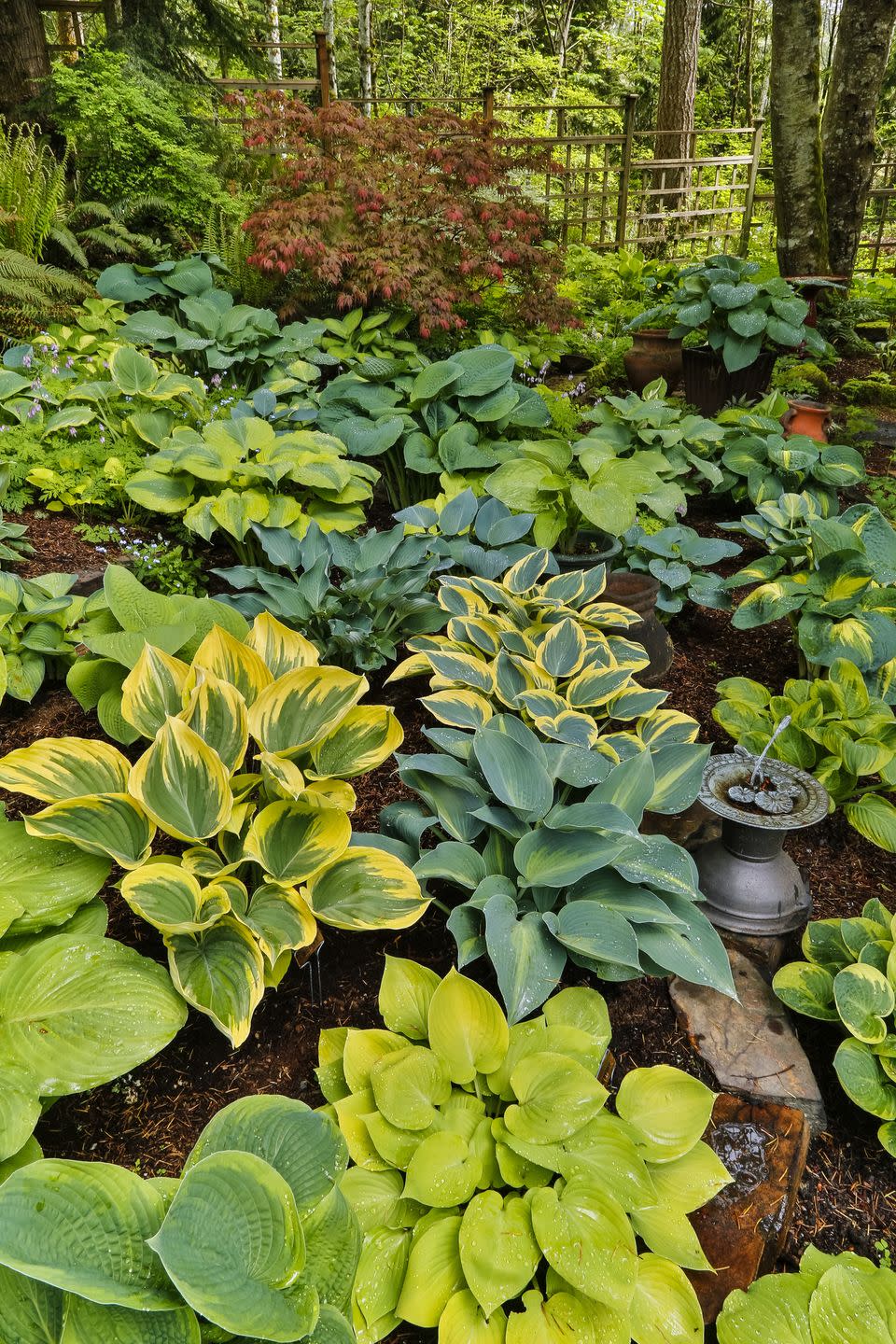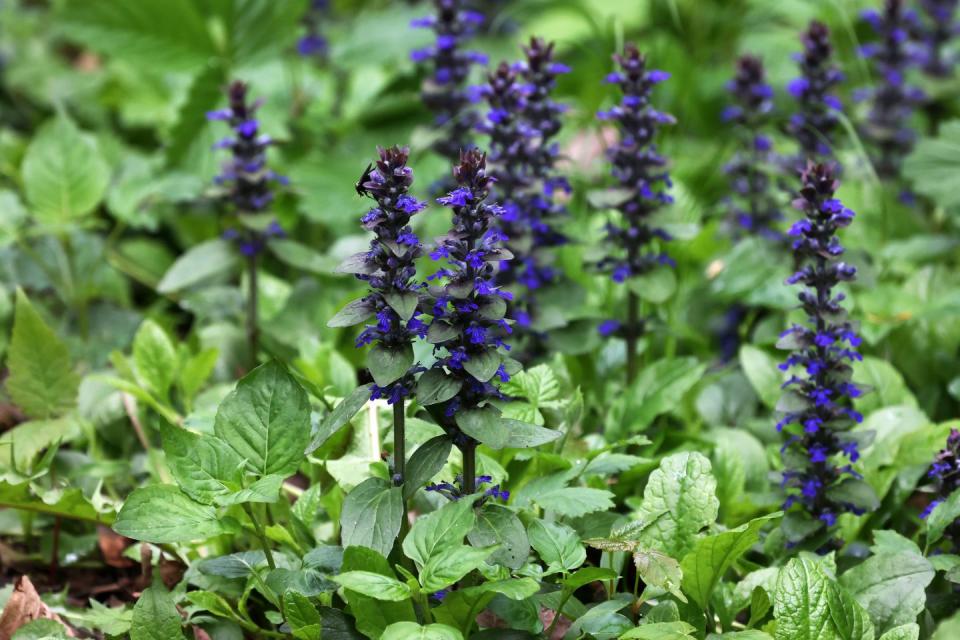These Flowers Actually Thrive in Shady Gardens

Your shady garden doesn't have to be boring and colorless! There are plenty of stunning shade perennials that thrive in full-shade locations, bringing color and vibrancy to low-light areas of your yard. Perennials are a good garden investment because they'll rebloom for many years. Many perennials also spread, so you can divide them to make new plants in subsequent seasons. To keep the color coming, remember that most perennials bloom for a period of weeks to months, while annuals add instant impact because they bloom from spring to fall. That's why it's a good idea to mix it up and include both annuals and perennials in your garden, so you'll have color throughout the growing season.
You'll also want to make sure you choose shade perennials that can survive winters in your USDA hardiness zones (find yours here). Also, keep in mind that perennials may take some time to get established in a new spot—the first year, they may not do much blooming while they put down roots. But in the second year, they'll become more vigorous. By the third season, they'll really take off!
How to Care for Shade Perennials
You can plant shade perennials any time of year, but the most ideal environmental conditions typically are in the early spring and mid-to-late fall when temperatures are more moderate and rainfall generally is more plentiful. If you plant them in summer, water them deeply. There's no sense spending money on plants that struggle due to heat and water stress. In addition, make sure to keep your perennials watered throughout the first season so they can set down strong roots.
Read on to learn about the 25 best shade perennials for your garden:
Learn more gardening tips:
Cranesbill
This pretty, low-growing perennial, also known as perennial geranium, has a lovely spicy-minty scent that also repels deer and rabbits. Cranesbill tolerates full sun but is more of a shade perennial. They have small white, pink, or purple flowers that bloom in late spring.
Related Story: 40 Deer-Resistant Plants and Flowers for Your Garden

Irish Moss
The delicate creeping foliage of Irish moss forms dense mats in the garden. When its tiny white flowers bloom in late spring, it looks irresistibly beautiful. Give it lots of moisture and shade, though it will tolerate some morning sun.
Related Story: 36 Beautiful Flower Images to Inspire Your Green Thumb

Toad Lily
With such an adorable name, you have to grow this shade perennial! Toad lily, named for its spotted flowers, blooms in mid-to-late summer. It needs part-to-full shade to do best.
Related Story: Maximalist Gardens Are Peak Summer Joy

Creeping Jenny
Creeping Jenny has a beautiful chartreuse color with tiny yellow flowers that appear in spring. Make sure to plant it somewhere you don't mind it spreading, as it can take over an area in a hurry (though it's easy to pull, if you don't want it spreading).
Related Story: The Best Gardening Gift Ideas

Vinca Minor
Also known as periwinkle, this charming groundcover tolerates full shade or a little morning sun. The pretty blue flowers of this shade perennial appear in late spring.
Related Story: 34 Best Low-Light Indoor Plants

Lily of the Valley
Lily of the valley has darling bell-shaped flowers with a strong floral scent. This perennial spreads rapidly, so plant it where it won't take over, such as between a house and a sidewalk. The fragrant flowers appear in spring.
Related Story: Designers Share Their Favorite Spring Flowers

Bletilla
The bletilla, or ground orchid, is a sturdy plant that loves moisture, so make sure to water deeply if you haven't had rain in a few days. This shade perennial will tolerate morning sun, and the pretty orchid-like blooms appear in early summer.
Related: The Most Beautiful Orchid Colors

Hosta
Hostas do well in shade, but for best leaf coloration, give them some morning sun. They're also a favorite of Bambi, so avoid planting (or protect with chicken wire cages) if deer frequent your garden. They do get tiny spikes of flowers that hummingbirds love in mid-summer.
Related Story: 26 Flowers That Attract Hummingbirds to Your Yard

Bleeding Heart
The striking flowers of this shade perennial make it worth planting! A bleeding heart takes several years to show its stuff, so be patient, and you'll be rewarded. Give it mostly shade with some morning sun for the best blooms. The flowers are pure white, red, or pink, and they appear in late spring.
Related Story: How to Organize Your Garden Shed

Japanese Forest Grass
With variegated gold and green foliage, Japanese forest grass lights up shady corners of your garden. It does prefer moist soils, but the beautiful arching leaves are deer-resistant.
Related Story: 10 Best Ornamental Grass Types for Gardens

Foamflower
Also called tiarella, the beautiful pale pink spikes of foamflower appear in late spring. When planted in masses, they resemble foam from a distance! The delicate flowers bloom for more than a month.
Related Story: How to Stop Crabgrass From Taking Over Your Lawn

Lamium
Also known by the not-so-glamorous name of dead nettle, this shade perennial makes a beautiful, low-maintenance ground cover. It tolerates sun but spreads faster in shade gardens. With silvery splashes on its foliage, lamium flowers bloom in pink, white, or purple in late spring to early summer.
Related Story: What Is Companion Growing?

Astilbe
The feathery flowers of astilbe appear in late spring, adding gorgeous, saturated color to the shade garden. They come in a variety of colors, including white and various shades of pink. The stunning plumes appear in summer; they're also deer-resistant.
Related Story: How to Keep Deer Out of Your Garden Naturally

Autumn Fern
The burnished fronds of autumn fern add subtle color to shady areas of your yard. They'll tolerate a little morning sun, but they do best in full shade. They'll spread rapidly in the right environment. They're also deer-resistant.
Related Story: The Best Evergreen Trees for Your Yard

Jacob's Ladder
The foliage of this shade perennial grows in an interesting ladder-like form, but the striking blue flowers are the real showstoppers. Make sure Jacob's ladder receives a few hours of sun each day for the best blooms. The flowers bloom for weeks in late spring to early summer.
Related Story: 15 Best Biennial Flowers to Grow

Bunchberry
Bunchberry is a low-growing groundcover that does well in shady areas. The white flowers, which resemble dogwood blossoms (it's in the same family), become bright red berries in the fall.
Related Story: David Beckham Has a Genius Gardening Hack

Japanese Painted Fern
The delicate fronds of Japanese painted fern are silver and burgundy, making it an elegant addition to the shade garden. It needs full shade but will tolerate some morning sun. It's deer-resistant.
Related Story: 17 Indoor Blooming Plants Even Beginners Can Keep Alive

Bugleweed
A mat of low-growing foliage makes this shade perennial an excellent groundcover. In summer, bright blue spikes of flowers appear on bugleweed. It can be an aggressive spreader, so make sure to contain it if you don't want it growing everywhere.
Related Story: How to Grow Gorgeous Climbing Vines On Your House

Coral Bells
Available in a wide range of colors from burgundy to chartreuse, coral bells make for a lovely groundcover. Tiny bell-shaped flowers, which hummingbirds love, appear early to mid-summer. Coral bells, also called heuchera, are deer- and rabbit-resistant.
Related Story: A Guide to Growing Coral Bells

Columbine
Columbines are early- to mid-spring bloomers, offering much-needed food early in the season for pollinators. The intricate flowers look delicate, but it's a tough shade perennial that will return for several years. Many types reseed themselves.
Related Story: How to Plant a Clover Lawn

Hellebore
This late-winter bloomer has exquisite flowers in a wide range of colors from pink to white to red. Give hellebores mostly shade, but they need some morning sun to bloom well. They're deer- and rabbit-resistant.
Related Story: 17 Winter Flowers That Actually Thrive in the Cold

Marsh Marigold
If you have a very moist area in the shade, these native flowers are a great option. The sunny yellow blooms, surrounded by heart-shaped leaves, appear in early spring.

Lungwort
This lovely, unassuming shade perennial, once believed to cure lung ailments, has pretty splashes of silver on its foliage. Salmon buds open into beautiful blue flowers in spring. They're deer- and rabbit-resistant.

Epimedium
This shade perennial is a low-growing groundcover that blooms in the spring. The delicate flowers are quite exquisite! But they don't like foot traffic, so plant them where you won't be walking or working in the garden frequently.

Virginia Bluebells
These native shade perennials look amazing when planted in masses under tall trees. They prefer moist soil, and the plants are ephemeral, meaning they disappear during the heat of summer. Not to worry: They'll be back (and spread) next year.

You Might Also Like


